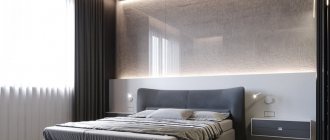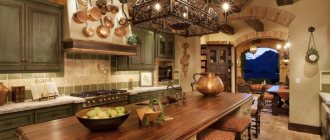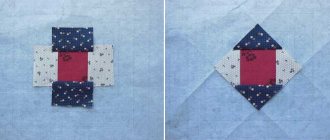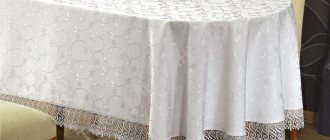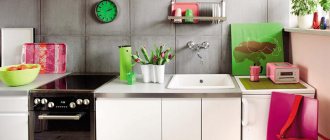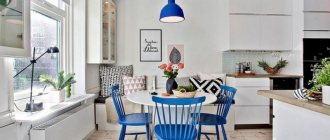And what is it?
Strictly speaking, it would be an exaggeration to call patchwork an independent style. This is a special weaving system using different flaps in one product.
But now the concept has expanded: it is used to decorate ceilings, walls and kitchen aprons.
Of course, the range of materials has also become wider - now the term refers not only to textiles, but also to tiles, wallpaper and even painting.
The popularity of patchwork and the closely related quilt (a special method of sewing quilted two-layer fabric) can be explained very simply: they can add coziness to any kitchen.
Let's figure out what its features are and how best to use this unusual technique in modern kitchen interiors.
Where is patchwork used?
As already mentioned, the patchwork style has long been associated not only with textiles - now it can be found on almost any surface. Where is the best place to use it in the kitchen? Let's figure it out now.
Of course, the most obvious option is kitchen textiles. Curtains, tablecloths, towels, coasters... Such colorful patchwork strokes will enliven and decorate the entire interior, so don’t be afraid to experiment with colors and textures.
Patchwork is the ideal solution for textiles
In addition, you can use a classic technique - a patchwork rug. Initially, the technique was developed specifically for weaving carpets, so such a move would be more than appropriate. A bright rug will make the kitchen cozier and the floor warmer.
In second place in popularity is the patchwork apron. Now manufacturers offer more than a wide selection of mosaic tiles in this style, so finding an option suitable for your interior will not be difficult.
Another interesting solution is the facades of the kitchen unit, decorated with patchwork. In this case, you should choose furniture made of glass or plastic so that you can apply an even and colorful print. However, keep in mind that such furniture must be handled with care - avoid patterns and bright colors in the rest of the kitchen design.
Patchwork looks good on headsets
Walls should be decorated with patchwork carefully. If you decorate four walls at once in this way, it will simply be impossible to stay in the room. Patchwork is a very catchy and defiant style, so it is better to decorate one wall and make the rest simple, monochromatic.
There should be only one bright wall
The same applies to the floor - if you decorated it with mosaics, keep the walls and ceiling as simple as possible.
Patchwork flooring is best complemented with plain walls and furniture
A patchwork ceiling is a very unusual solution. It is best to order a stretch ceiling with a print: laying tiles on the ceiling is very difficult.
Part of the ceiling is decorated in crazy patchwork style
Patchwork style furniture also looks quite unusual. This could be a pattern on the tabletop and, more predictably, the upholstery of chairs or a kitchen corner.
Patchwork upholstery
Let's try to combine
To be honest, the idea of decorating the entire room in this style does not seem very successful to us: the result will be too colorful and will tire the eyes. But making it an accent is a great solution.
It would be logical to assume that such flashy decor is not appropriate everywhere - for example, it is difficult to imagine it in a classic kitchen or, conversely, in a high-tech room.
But for Provence, country, Scandinavian or Mediterranean design, this is what you need.
The patchwork style looks no less impressive in the interiors of kitchens made in the shabby chic or boho traditions - wherever bright colors and ethnic patterns are welcome.
But in general, you can always experiment - probably a good specialist will help you develop a design project with a successful combination of this style and loft. The main thing is to imagine how such a combination will look in real life, so that later you don’t have to hastily redo the renovation.
To do this, you need to understand all the nuances well. Let's get started?
Style Features
It is very important to understand that patchwork is a rather capricious and demanding style. It is difficult to combine with other stylistic trends due to its brightness and catchy appearance. Therefore, if you want to create a kitchen in a patchwork style, it is extremely important to take into account all its features.
Patchwork has its own rules and traditions
First of all, keep in mind that decorating the entire kitchen with patchwork is not the best idea. A room decorated in this way will turn out to be too colorful and saturated, even if you use pastel shades.
Too many patterned surfaces will soon begin to tire your eyes and irritate you. Therefore, patchwork is often used as an accent: they decorate one of the walls, an apron or furniture. Try not to overdo it - patchwork looks very stylish in small quantities, but if there is too much of it, it turns into cheap kitsch.
Important : Think about the appropriateness of patchwork. Country style or Provence? It will be an excellent decoration. But it’s quite difficult to imagine patchwork in a strict Victorian interior or ultra-modern high-tech. True, if you like fusion, you can experiment.
Despite the fact that patchwork is now used to decorate any interior items, initially it was still work with textiles. Therefore, if you want to create an authentic patchwork interior, work with fabrics. Curtains, tablecloths, towels and potholders...
Patchwork textiles are very diverse
Patchwork allows you to create a canvas of suitable texture for any purpose. Experiment with different combinations.
By the way: Another advantage of patchwork is that it can be used to revitalize an existing interior. Fabric elements will fit into most designs without much difficulty. In addition, even a person who is not particularly familiar with needlework can weave towels or a tablecloth using this technology. The main thing is to choose the right fabrics.
One of the advantages of patchwork is that it allows you to combine almost any color - the main thing is that in the end you get a harmonious composition. So feel free to mix your favorite shades.
Mix your own shades - brightness is not considered a minus here
Patchwork on tiles, furniture or wallpaper looks like a rather complex mosaic. You can paint the surfaces yourself or purchase ready-made products. However, keep in mind that objects in this technology look quite catchy.
Therefore, their framing should be made as neutral as possible: choose plain coatings and smooth textures. When it comes to color, you can go two ways. Or make the background light - white, beige, ivory. Or use one of the shades used in patchwork mosaic.
If you choose patchwork to decorate your kitchen, minimize the use of accessories and decorative items. This is a stylistic addition in itself, so unnecessary decorations will overwhelm your kitchen.
Keep a sense of proportion
Patchwork is characterized by bright, rich colors and catchy patterns. You understand that if you make a similar design on all the walls or ceiling, then very soon the kitchen will tire you?
It attracts attention, so we recommend using it to accent some piece of furniture or decor. Don’t make it predominant—one or two elements are enough.
- In a small kitchen, use it to decorate a backsplash with tiles or create an original wicker curtain from patches;
- On a large one - for a panel or mosaic fresco. Measure the dimensions so as not to overdo it.
You can deviate from this rule only for a kitchen made in the style of shabby chic or boho chic - where such exaggeration sometimes becomes a highlight.
Features of laying tiles in patchwork style
The principle of laying out a future pattern on the floor is relevant not only for mosaic tiles. It wouldn’t hurt to lay out large slabs to evaluate the overall appearance. After this, markings are made on the wall itself using chalk: the outline of the kitchen unit, stove, refrigerator and other kitchen elements that will border the apron are applied. Then the lines of the edges of the cladding are drawn on the wall, and a metal profile or wooden beam is attached to the lower border. Next, they begin to lay out the tiles, applying a thick layer of glue in advance.
Advice. After laying each row of tiles, do not forget to check the lines for symmetry using a building level.
If you ultimately want to get a visually seamless ceramic canvas, choose large tiles with a smooth, glossy surface without texture. A thin grout joint will help achieve the desired effect. Also, do not forget about special solutions against mold and fungi that are used to treat joints.
Let's say you haven't purchased a kitchen set yet, and it's impossible to measure the space for the work surface. Then, when installing the tile covering on the apron, they are guided by the average standards on which the working surface is located - 85 cm from the floor and 70 cm in height. The tiles are laid so that the upper border is slightly “hidden” behind the upper wall cabinets, and the lower border, accordingly, is hidden behind the lower drawers.
Lots of textiles
As we said earlier, first of all it is working with fabric. Yes, the motifs have transferred to other materials. But if you want a truly authentic style, you'll have to focus on textile accessories.
Their choice is unusually wide: starting from rugs covering the entire floor (we think this idea will be especially appreciated by those who live in a private house without heated floors) and ending with such little things as covers for stands for devices and potholders made by themselves.
The undoubted advantage of this type of decor is the ability to make it yourself. The execution method has its own characteristics, but it is not too difficult to learn - the main thing is a little perseverance.
Tips for craftsmen on laying multi-colored kitchen aprons
Before you begin, lay out the tiles and select combinations.
- The entire future covering is marked, the contours of at least several laid modules are drawn with chalk. Lines are drawn on the boundaries of the apron, less than which the coating cannot be made. The location of the modules is covered with a moderate layer of primer. A metal profile or a thin wooden block runs along the lower border. Using a building level, the symmetry of the lines is checked.
- Glue for modules is diluted in a container or poured out of the packaging as a liquid into a convenient bucket or bowl. There is no need to expose the entire adhesive composition to open air, since the tiles take quite a long time to lay, which is why it can dry out.
- The glue is applied in a thick layer. A notched trowel passes over it. Smooth and fairly deep furrows are produced.
- The first row is carefully placed. Plastic crosses are used as seams. After installing each tile, you need to check the clarity of the lines using a building level.
- When the full size of the tile does not fit into the corner of the wall, you can use a grinder or a special tile cutter to cut it. A diamond blade must first be inserted into the devices.
- Significant unevenness on the walls should not be ignored. An additional layer of adhesive equal to the recess should be applied to the tile, and then installed correctly so that the fastening material fills the hole. If the adhesive is applied to the tiles, it should also be grooved with a notched trowel.
- After installing the tiles, you need to check the entire surface for any adhesive on the front side. If this happens, you need to completely clean the stained areas as quickly as possible.
- When the glue has dried, usually the next day after installation, the joints are cleaned of excess glue and the plastic crosses are removed.
- A protective coating for the joints is applied to the finished surface and general grouting is performed.
How to properly glue tiles to the wall and tips from the master, see our video:
Internationality
Initially we said that the style originated in England. However, now it has become widespread - such a technique is often found in Japanese or French styles or a completely unexpected Art Deco patchwork.
The latter is distinguished by a more sophisticated range using pastel and golden shades.
Therefore, no matter what repair you decide to do, you will most likely find suitable patchwork accessories.
Headset functionality
I have two children, so I cook a lot, I often use a slow cooker, a juicer, and a blender. It’s inconvenient for me to take equipment out of the cabinets every time. And storing it on the countertop is unsightly. And we figured out how to solve this problem: we hid an additional shelf behind the column. When you go into the kitchen, you can't see her. And the drawers under this shelf are very convenient, shallow - I store cereals there. You open it and you immediately see where everything is.
I store frying pans, pots and iron plates in drawers. They are large and located at the bottom. I feel so comfortable.
Choose wisely
In addition to national characteristics, the method of execution also differs. No matter what you decide to decorate in this style - curtains or a patchwork tile backsplash for the kitchen, understanding the types will help you make a choice.
For example, crazy is suitable for shabby chic - lack of symmetry, a large number of frills and decorative elements. But for Provence, the watercolor technique is suitable - soft tones, as if flowing into each other.
An unusual and catchy ornament is “honeycomb”. It will not suit every design, but if you can choose a worthy background for such wallpaper or a textile element, then it will become a real decoration of the room..
This technique in the interior of a home kitchen can be both a winning solution and a tool that will blur the entire impression - think three times before making the final choice.
Types of patchwork
This section may cause confusion for many - what types of ordinary patchwork weaving can there be? However, patchwork is a rather complex technology with its own traditions. There are several types of patchwork.
Patchwork has many subtypes
Traditional patchwork is criss-cross weaving, using similar colors or shades that are simply in harmony with each other. This ornament looks very cozy. It suits chalet, country, and Scandinavian styles. Its main advantage is its traditional nature, reflected in the name. If desired, traditional patchwork made in natural colors can even fit into a classic interior.
A more daring solution is the so-called crazy patchwork. A characteristic feature of this type of patchwork is the use of free-form figures, often irregular, as well as curved stripes and non-standard appliqués. These can be either figures of plants and animals, or just an unusual mixture of all colors and textures.
Crazy patchwork allows any experiments
The same trends are reflected on hard surfaces - catchy colors, chaotic patterns, unusual shapes. This patchwork is considered quite capricious - it is difficult to fit into the interior. If you like such flashy solutions, it is better to decorate the rest of the kitchen in a minimalist style.
In knitted patchwork, the patches are not sewn together, but are crocheted to each other with threads of a suitable color. In this case, the shreds can be either fabric or knitted. In the kitchen, this substyle is reflected in the smooth elements of the ornament, as if flowing into each other. A very elegant and stylish solution that is suitable for interiors in Provence or country style.
Knitted patchwork works well for potholders and napkins
Despite the fact that patchwork originally originated in England, modern designers love to add a wide variety of ethnic motifs to it. For example, Japanese patchwork uses quilting and silk fabrics. The patterns are based on geometric shapes: triangles, squares, corners, rhombuses.
Japanese patchwork is characterized by attention to detail.
Ornaments should be designed in the same way: clear geometric shapes, strict lines and pure tones.
The “quick squares” technique, beloved by many, is almost ideal for decorating a backsplash or wall with ceramic tiles. You will need two types of mosaic tiles in contrasting tones. By alternating them with familiar chess patterns to many, you will be able to create a bright and attractive surface.
Great rug for the kitchen
Patchwork using the watercolor technique looks very gentle and unusual. A smooth transition from light to dark tones creates the effect of painting with watercolors. You will need tiles of at least seven tones with small patterns. If this technique seems too complicated for you, you can order plastic or glass panels or wallpaper with a watercolor patchwork print.
A very unusual solution
The stripe-to-strip technique involves straight, zigzag or wavy stripes placed in a certain way. In our opinion, this solution is ideal for a small kitchen - with the help of patchwork you will not only decorate it, but also make it visually taller or wider.
Such a rug or tablecloth will enliven the interior
An interesting technique is the log cabin. This method is also based on stripes that are collected around a central square and arranged in a spiral. The central square can be moved to a corner, then you will get an interesting pattern that spreads out to the sides.
Looks good both on textiles and on an apron
Honeycombs created from hexagonal coverings also look beautiful. True, finding suitable tiles will be difficult. But to decorate wallpaper or facades in this way - why not?
The honeycombs look very cozy
Weaving from wallpaper?
In fact, you don't need to do this. But you will have to think about which pieces to choose to create a patchwork mosaic.
As we have already said, one of the main features of the technique is rich and bright colors. For those who decide to buy a ready-made canvas, you just need to choose the one you like.
If you plan to choose a wallpaper design yourself in order to make a truly unique coating, you will need to work hard. However, modern technologies will solve the problem for you - there are programs that will find beautiful color combinations.
As for general recommendations, they are extremely simple:
- Select only one wall with patchwork, otherwise the kitchen will be too colorful.
- Choose wallpaper of different colors and textures, but of the same thickness.
- The remaining walls and decor should be as monochromatic as possible to highlight the beauty of the complex coating.
Apron in patchwork style
A patchwork apron for the kitchen is the most popular option. This element becomes a noticeable, expressive accent, gives the work area a cheerful note, and enlivens the interior. Sometimes after large-scale renovations, tiles of different shades, with patterns and plain ones remain. Since the style does not limit the choice of elements, these materials can become components of one composition. However, it is usually not possible to create a beautiful, high-quality patchwork apron in the kitchen in this way.
The patchwork of the apron should clearly match the contours of the surrounding furniture
Many manufacturers offer special design kits. A patchwork apron for the kitchen can be made from:
- ceramic tiles;
- mosaics;
- plastic.
If you purchase standard tiles of different shades to create an accent, you need to choose materials of the same brand. The optimal size of the elements is 10x10. The advantage of this method is the ability to accurately select shades taking into account the features of the interior, and create a unique pattern or ornament.
A bright apron breaks up the monotonous white kitchen interior
A beautiful patchwork apron in the kitchen is made from mosaic. This material is produced from various raw materials. There are glass, metal and ceramic mosaics. Smalt tiles are ideal for kitchens. If the sun's rays fall on it, a glow is formed, giving it a special charm.
Modern technologies make it possible to create plastic that has increased strength and resistance to various influences. Special patchwork tiles for kitchen backsplashes are available in a wide range. For any style you can find the best option.
Laying tiles is not difficult for homely owners. You can create a patchwork apron for the kitchen with your own hands, without involving professional specialists.
What about the tiles?
Floor or wall tiles laid in a patchwork style are almost as common as textile accessories.
The same rules apply here as for wallpaper - everything should be bright, but harmonious. Do not try to mix all the colors at once - such a move will definitely be overkill. But choosing tiles of different shapes is a good solution.
If you are not sure that you can do the work yourself efficiently, then it is better to turn to professionals - accuracy is very important.
We recommend that you first study a number of photos - this will help you decide on the intended pattern.
Advantages and disadvantages
Like any other style in the interior, patchwork has its advantages and disadvantages, which can attract or repel a potential buyer. Fortunately, there are many more positive benefits to using it.
Advantages:
- no restrictions for imagination - you can assemble your own unique composition from different modules;
- it is permissible to create combinations of tiles of different colors, collections, sizes and main features;
- a wide range represented by dozens of well-established manufacturers;
- the ability to select modules in a patchwork style to suit any kitchen interior for maximum compatibility.
Flaws:
- There may be difficulties in selecting the right set of modules, which is why they will not be combined with each other;
- the need to carefully select the design of the tiles if the kitchen is designed in a bright or unusual style;
- The backsplash draws attention and may seem too bright, making it not fit into the style of the space.
All the disadvantages of the patchwork style for a kitchen apron are very arbitrary, and for many people they do not matter. But the advantages are very significant, and set the patchwork masterpiece apart from other options.
Important ! It is recommended to purchase modules made in Italy, as they are distinguished by an interesting design and the highest quality and reliability.
Possible combinations
As you already understand, giving patchwork a dominant place in a kitchen renovation is a mistake. But in this case, you need to take a responsible approach to the choice of materials that shade it.
Turning to the history of the appearance of technology, it becomes clear that this is a rural invention. So it would be logical to use natural materials (or their high-quality imitation) - stone, wood, ceramics.
Try to avoid overly modern surfaces - plastic and glass can look good together with patchwork, but then there is no need to talk about respecting its stylistic features.
Make sure that the intended design project in the interior will look as great as in the photo - some people underestimate the brightness of such decorative elements against the backdrop of more restrained coatings.
How we chose the color
I was scared of the white kitchen. An alternative to it is “cashmere”. I have already seen it before in kitchens where there are contrasting dark facades. And he seemed bright to me. In fact, it looks quite dark in our kitchen. The sun shines through the window only until lunchtime, so the facades could have been made lighter, like in this snow-white kitchen with red curtains.
We chose the tabletop in the Scandi tradition – wood-look. I like the appearance of it, but the coating is slightly rough, so I have to wipe it with effort.
Apron in patchwork style. We used tiles from the KERAMA MARAZZI brand.
We combined colors to create a harmonious picture. 70% of the color in the kitchen is gray-violet, 20% is blue and 10% is wood.
Don't forget about the little things
Even if you decorate your kitchen with a huge wicker panel covering an entire wall, the true manifestation of the patchwork style is reflected in the small details.
Think about what items you would like to place additional emphasis on: they should resonate with the main element, as if emphasizing and shading it.
Don’t be afraid to use handmade ones - it will add uniqueness to the room, which is so valued by lovers of this technology.
What can we say in conclusion? Patchwork is a unique stylistic addition that will help create an atmosphere of warmth and comfort in the kitchen. But you need to be very careful with it - no overdoing it, otherwise the effect will be exactly the opposite.
Personally, we would recommend it to those who like bright things “with history.” But for lovers of more classic interiors, we advise you to look at the special section of our website.
Patchwork tiles for the kitchen
Patchwork looks especially impressive in light kitchens with white, milky, creamy and beige facades. Ornaments can contain 2 colors or be multi-colored. You can choose combinations to suit your taste or buy ready-made kits. The following designs are chosen for the kitchen:
- in beige and brown tones;
- black, blue or gray and white;
- with the effect of old faded;
- plaid and polka dots;
- geometric or abstract.
Origin story
Patchwork translated from English means “patchwork” - creating a canvas from individual fragments with different colors and patterns. Elements of this technique have long been used in the culture of many countries for sewing blankets, bedspreads, pillows, and rugs, which were cheap and created coziness. Today they are used in rustic-style interiors.
At the beginning of the twentieth century, with the Art Nouveau style came a fashion for natural lines, combining the influence of the East and the desire for constructiveness. Innovations affected the decoration of tiles: instead of drawings on biblical themes and images of nature, floral and geometric patterns of various shapes began to be printed on tiles.
This period is considered to be the appearance of the first patchwork tiles. The products were sold individually; for a long time the patterns on them were monochrome.
The production of inexpensive tiles with multi-colored motifs became possible with the introduction of industrial digital printing technology. In 2013, at the Cersaie exhibition in Italy, patchwork tiles with patterns that were as close as possible to sewing from pieces of fabric were presented, which created a stir.
As a result, hundreds of the world's leading factories began to produce collections with contrasting geometric ethnic patterns, focusing on the mass consumer and popular fabric colors, experimenting and offering new options every season.
Since 2020, the bright colors began to change to calmer and neutral colors of vintage chintz, which fit into different interior styles, and more monochrome options have appeared. Manufacturers combine opposites on one surface: abstraction, texture, line, composition.
How to use?
Patchwork tiles are used:
- for finishing kitchen aprons;
- creating panels;
- dividing the room into zones;
- for decorating the inside of open cabinets;
- identifying niches (outside or inside);
- design of columns, racks.
The tiles are laid on the floor and the risers of the closed staircase are decorated. Its installation must be carefully considered in order to achieve the greatest effect and not overload the room.
Patchwork is suitable for the following rooms:
- kitchen;
- dining room;
- bathroom or toilet;
- balcony;
- veranda;
- corridor;
- living room.
What patchwork looks best in the kitchen?
Both variegated patterns and calm ones, combining 2-3 colors, are suitable for the kitchen.
Popular two-color sets:
- with simple white designs on a muted colored background;
- gray-brown with simple geometry;
- blue-white, giving a feeling of freshness;
- black and white, giving elegance.
If the room is small, a large contrasting pattern will make it visually smaller. Products with a bright multi-color pattern can be alternated with plain ones that have the same edge.
Tiles look good in the kitchen:
- bright in the style of Italian classics;
- with multi-colored light pastel shades;
- with antique imitation;
- with floral, graphic or fantasy patterns;
- monochrome with a slightly blurred pattern;
If the kitchen has access to the balcony, it is also worth adding patchwork to its design.

